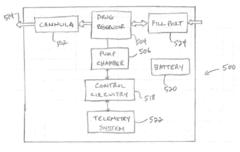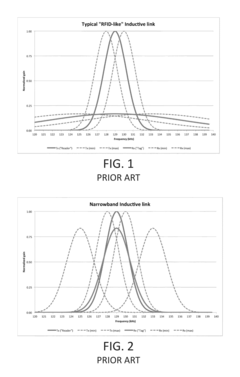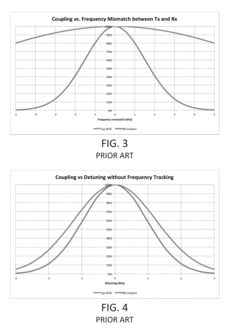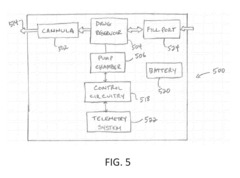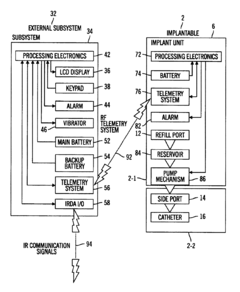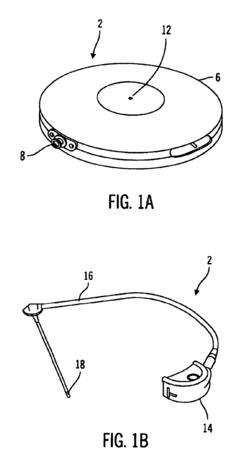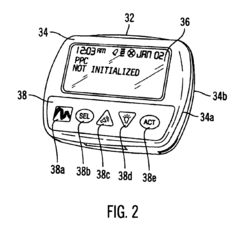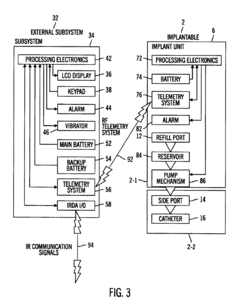How induction motors support advancements in telemedical equipment
AUG 18, 20259 MIN READ
Generate Your Research Report Instantly with AI Agent
Patsnap Eureka helps you evaluate technical feasibility & market potential.
Induction Motors in Telemedicine: Background and Objectives
Induction motors have played a pivotal role in the advancement of telemedical equipment, revolutionizing the healthcare industry's ability to provide remote medical services. The evolution of these motors has been closely intertwined with the development of telemedicine, dating back to the early 20th century when rudimentary forms of remote healthcare began to emerge.
The primary objective of incorporating induction motors into telemedical equipment is to enhance the precision, reliability, and efficiency of remote medical procedures. These motors provide the necessary mechanical power to operate various medical devices, from robotic surgical systems to advanced imaging equipment, enabling healthcare professionals to deliver high-quality care across vast distances.
As telemedicine has grown in importance, particularly in recent years due to global health challenges, the demand for more sophisticated and compact induction motors has intensified. The technological progression of these motors has been driven by the need for improved power-to-weight ratios, enhanced energy efficiency, and greater controllability in medical applications.
One of the key trends in the development of induction motors for telemedicine has been the miniaturization of components without compromising performance. This has allowed for the creation of smaller, more portable telemedical devices that can be easily transported to remote locations or used in space-constrained environments.
Another significant trend is the integration of smart technologies into induction motors, enabling real-time monitoring and adjustment of motor performance. This advancement has been crucial in ensuring the precision and safety of telemedical procedures, particularly in applications such as remote-controlled surgical robots.
The evolution of induction motors in telemedicine has also been marked by improvements in materials science. The use of advanced materials has led to motors with higher temperature tolerances, improved durability, and reduced electromagnetic interference, all of which are critical factors in medical environments.
Looking ahead, the continued development of induction motors is expected to focus on further enhancing their efficiency, reducing their environmental impact, and improving their integration with emerging technologies such as artificial intelligence and the Internet of Things. These advancements will be instrumental in expanding the capabilities and reach of telemedical services, ultimately contributing to more accessible and higher quality healthcare worldwide.
The primary objective of incorporating induction motors into telemedical equipment is to enhance the precision, reliability, and efficiency of remote medical procedures. These motors provide the necessary mechanical power to operate various medical devices, from robotic surgical systems to advanced imaging equipment, enabling healthcare professionals to deliver high-quality care across vast distances.
As telemedicine has grown in importance, particularly in recent years due to global health challenges, the demand for more sophisticated and compact induction motors has intensified. The technological progression of these motors has been driven by the need for improved power-to-weight ratios, enhanced energy efficiency, and greater controllability in medical applications.
One of the key trends in the development of induction motors for telemedicine has been the miniaturization of components without compromising performance. This has allowed for the creation of smaller, more portable telemedical devices that can be easily transported to remote locations or used in space-constrained environments.
Another significant trend is the integration of smart technologies into induction motors, enabling real-time monitoring and adjustment of motor performance. This advancement has been crucial in ensuring the precision and safety of telemedical procedures, particularly in applications such as remote-controlled surgical robots.
The evolution of induction motors in telemedicine has also been marked by improvements in materials science. The use of advanced materials has led to motors with higher temperature tolerances, improved durability, and reduced electromagnetic interference, all of which are critical factors in medical environments.
Looking ahead, the continued development of induction motors is expected to focus on further enhancing their efficiency, reducing their environmental impact, and improving their integration with emerging technologies such as artificial intelligence and the Internet of Things. These advancements will be instrumental in expanding the capabilities and reach of telemedical services, ultimately contributing to more accessible and higher quality healthcare worldwide.
Telemedicine Market Demand Analysis
The telemedicine market has experienced significant growth in recent years, driven by advancements in technology, increasing healthcare costs, and the need for improved access to medical services. This demand has been further accelerated by the global COVID-19 pandemic, which highlighted the importance of remote healthcare solutions.
Market research indicates that the global telemedicine market size was valued at approximately $50 billion in 2019 and is projected to reach over $200 billion by 2026, growing at a compound annual growth rate (CAGR) of around 25%. This rapid expansion is attributed to several factors, including the rising prevalence of chronic diseases, an aging population, and the growing adoption of digital health technologies.
In developed countries, the demand for telemedicine services is primarily driven by the need to reduce healthcare costs and improve patient outcomes. For instance, in the United States, telemedicine has shown potential to save up to $6 billion annually in healthcare costs. Additionally, it has been observed that telemedicine can reduce hospital readmissions by up to 19%, contributing to improved patient care and cost savings.
Emerging markets are also witnessing a surge in telemedicine adoption, particularly in rural and underserved areas where access to healthcare facilities is limited. Countries like India and China are investing heavily in telemedicine infrastructure to bridge the healthcare gap between urban and rural populations.
The demand for telemedical equipment, including those utilizing induction motors, is expected to grow in tandem with the overall telemedicine market. Induction motors play a crucial role in various telemedical devices, such as robotic surgical systems, remote patient monitoring equipment, and diagnostic imaging machines.
Key market segments driving the demand for telemedicine include teleconsultation, telemonitoring, and tele-surgery. Teleconsultation, which allows patients to consult with healthcare providers remotely, is expected to hold the largest market share due to its convenience and cost-effectiveness. Telemonitoring, particularly for chronic disease management, is anticipated to witness substantial growth as it enables continuous patient monitoring and early intervention.
The COVID-19 pandemic has acted as a catalyst for telemedicine adoption, with many countries relaxing regulations to facilitate remote healthcare services. This has led to a surge in demand for telehealth platforms and associated equipment, creating new opportunities for manufacturers of telemedical devices incorporating induction motors.
Market research indicates that the global telemedicine market size was valued at approximately $50 billion in 2019 and is projected to reach over $200 billion by 2026, growing at a compound annual growth rate (CAGR) of around 25%. This rapid expansion is attributed to several factors, including the rising prevalence of chronic diseases, an aging population, and the growing adoption of digital health technologies.
In developed countries, the demand for telemedicine services is primarily driven by the need to reduce healthcare costs and improve patient outcomes. For instance, in the United States, telemedicine has shown potential to save up to $6 billion annually in healthcare costs. Additionally, it has been observed that telemedicine can reduce hospital readmissions by up to 19%, contributing to improved patient care and cost savings.
Emerging markets are also witnessing a surge in telemedicine adoption, particularly in rural and underserved areas where access to healthcare facilities is limited. Countries like India and China are investing heavily in telemedicine infrastructure to bridge the healthcare gap between urban and rural populations.
The demand for telemedical equipment, including those utilizing induction motors, is expected to grow in tandem with the overall telemedicine market. Induction motors play a crucial role in various telemedical devices, such as robotic surgical systems, remote patient monitoring equipment, and diagnostic imaging machines.
Key market segments driving the demand for telemedicine include teleconsultation, telemonitoring, and tele-surgery. Teleconsultation, which allows patients to consult with healthcare providers remotely, is expected to hold the largest market share due to its convenience and cost-effectiveness. Telemonitoring, particularly for chronic disease management, is anticipated to witness substantial growth as it enables continuous patient monitoring and early intervention.
The COVID-19 pandemic has acted as a catalyst for telemedicine adoption, with many countries relaxing regulations to facilitate remote healthcare services. This has led to a surge in demand for telehealth platforms and associated equipment, creating new opportunities for manufacturers of telemedical devices incorporating induction motors.
Current State and Challenges of Induction Motors in Telemedicine
The integration of induction motors in telemedical equipment has significantly advanced the field of telemedicine, enabling more sophisticated and reliable remote healthcare solutions. Currently, induction motors play a crucial role in various telemedical devices, including robotic surgical systems, remote patient monitoring equipment, and automated medication dispensers. These motors provide precise control, smooth operation, and consistent performance, which are essential for the accuracy and reliability required in medical applications.
However, the current state of induction motor technology in telemedicine faces several challenges. One of the primary issues is the need for miniaturization without compromising performance. As telemedical devices become more compact and portable, induction motors must be scaled down while maintaining their power output and efficiency. This presents a significant engineering challenge, as smaller motors typically have reduced torque and power capabilities.
Another challenge is the requirement for enhanced energy efficiency. Telemedical equipment often operates in remote or resource-constrained environments, making power consumption a critical factor. Improving the energy efficiency of induction motors used in these devices is essential for extending battery life and reducing the overall power requirements of telemedical systems.
Electromagnetic interference (EMI) is also a significant concern in the current state of induction motor technology for telemedicine. Medical devices are highly sensitive to electromagnetic disturbances, which can affect their accuracy and reliability. Developing induction motors with reduced EMI emissions while maintaining their performance characteristics is crucial for ensuring the safety and effectiveness of telemedical equipment.
The integration of smart features and connectivity in induction motors presents both opportunities and challenges. While the ability to monitor motor performance, predict maintenance needs, and adjust operations remotely can greatly enhance the functionality of telemedical devices, it also introduces complexities in terms of data security and system reliability.
Durability and reliability under varying environmental conditions remain ongoing challenges. Telemedical equipment may be deployed in diverse settings, from controlled hospital environments to remote field locations. Induction motors must maintain consistent performance across a wide range of temperatures, humidity levels, and other environmental factors to ensure the reliability of telemedical services.
Lastly, the cost-effectiveness of advanced induction motor technologies in telemedical applications is a significant consideration. While high-performance motors offer superior capabilities, their integration into telemedical devices must be balanced against the overall cost of the equipment to ensure accessibility and widespread adoption of telemedicine solutions.
However, the current state of induction motor technology in telemedicine faces several challenges. One of the primary issues is the need for miniaturization without compromising performance. As telemedical devices become more compact and portable, induction motors must be scaled down while maintaining their power output and efficiency. This presents a significant engineering challenge, as smaller motors typically have reduced torque and power capabilities.
Another challenge is the requirement for enhanced energy efficiency. Telemedical equipment often operates in remote or resource-constrained environments, making power consumption a critical factor. Improving the energy efficiency of induction motors used in these devices is essential for extending battery life and reducing the overall power requirements of telemedical systems.
Electromagnetic interference (EMI) is also a significant concern in the current state of induction motor technology for telemedicine. Medical devices are highly sensitive to electromagnetic disturbances, which can affect their accuracy and reliability. Developing induction motors with reduced EMI emissions while maintaining their performance characteristics is crucial for ensuring the safety and effectiveness of telemedical equipment.
The integration of smart features and connectivity in induction motors presents both opportunities and challenges. While the ability to monitor motor performance, predict maintenance needs, and adjust operations remotely can greatly enhance the functionality of telemedical devices, it also introduces complexities in terms of data security and system reliability.
Durability and reliability under varying environmental conditions remain ongoing challenges. Telemedical equipment may be deployed in diverse settings, from controlled hospital environments to remote field locations. Induction motors must maintain consistent performance across a wide range of temperatures, humidity levels, and other environmental factors to ensure the reliability of telemedical services.
Lastly, the cost-effectiveness of advanced induction motor technologies in telemedical applications is a significant consideration. While high-performance motors offer superior capabilities, their integration into telemedical devices must be balanced against the overall cost of the equipment to ensure accessibility and widespread adoption of telemedicine solutions.
Existing Applications of Induction Motors in Telemedical Devices
01 Design and construction of induction motors
This category covers the fundamental design and construction aspects of induction motors, including rotor and stator configurations, winding arrangements, and core materials. Innovations in these areas aim to improve motor efficiency, power output, and overall performance.- Design and construction of induction motors: This category covers the fundamental design and construction aspects of induction motors, including rotor and stator configurations, winding arrangements, and core materials. Innovations in these areas aim to improve efficiency, power output, and overall performance of the motors.
- Control systems for induction motors: Control systems play a crucial role in regulating the speed, torque, and efficiency of induction motors. This category includes advancements in motor drives, frequency converters, and intelligent control algorithms that enhance the motor's performance and adaptability to various operating conditions.
- Efficiency improvements in induction motors: This category focuses on techniques and technologies aimed at increasing the energy efficiency of induction motors. It includes innovations in motor design, materials, and manufacturing processes that reduce losses and improve overall motor performance.
- Specialized applications of induction motors: Induction motors are used in a wide range of specialized applications, each with unique requirements. This category covers adaptations and modifications of induction motors for specific industries or operating environments, such as high-speed applications, harsh conditions, or integration with specific machinery.
- Maintenance and diagnostics of induction motors: This category encompasses methods and systems for monitoring, maintaining, and diagnosing induction motors. It includes techniques for fault detection, predictive maintenance, and condition monitoring to ensure optimal performance and longevity of the motors.
02 Control systems for induction motors
This point focuses on the development of control systems and methods for induction motors. It includes advancements in speed control, torque regulation, and power factor correction. These control systems aim to enhance motor performance, energy efficiency, and adaptability to various operating conditions.Expand Specific Solutions03 Efficiency improvements in induction motors
This category encompasses innovations aimed at improving the energy efficiency of induction motors. It includes techniques for reducing losses, optimizing magnetic circuits, and enhancing thermal management. These advancements contribute to reduced energy consumption and improved motor performance.Expand Specific Solutions04 Specialized applications of induction motors
This point covers the adaptation and optimization of induction motors for specific applications. It includes designs for high-speed operations, heavy-duty industrial use, and integration with renewable energy systems. These specialized motors are tailored to meet the unique requirements of various industries and operating environments.Expand Specific Solutions05 Manufacturing and assembly techniques for induction motors
This category focuses on innovative manufacturing and assembly methods for induction motors. It includes advancements in production processes, materials selection, and quality control techniques. These innovations aim to improve motor reliability, reduce production costs, and enhance overall manufacturing efficiency.Expand Specific Solutions
Key Players in Telemedicine and Induction Motor Industries
The advancement of induction motors in telemedical equipment is currently in a growth phase, with the market expanding rapidly due to increasing demand for remote healthcare solutions. The global telemedical equipment market is projected to reach significant size in the coming years, driven by technological innovations and the need for efficient healthcare delivery. Companies like Medtronic, Inc., Intuitive Surgical Operations, Inc., and Boston Scientific Neuromodulation Corp. are at the forefront of this technological evolution, developing sophisticated induction motor-based systems for various telemedical applications. The technology's maturity is progressing, with these key players investing heavily in research and development to enhance the precision, efficiency, and reliability of induction motors in telemedical devices, paving the way for more advanced and accessible remote healthcare solutions.
Medtronic, Inc.
Technical Solution: Medtronic has developed advanced induction motor-based systems for telemedical equipment, focusing on precision control and remote operation. Their technology integrates high-efficiency induction motors with advanced sensors and telemetry systems, allowing for real-time monitoring and adjustment of medical devices from a distance. The company's approach includes the use of variable frequency drives to optimize motor performance and energy efficiency in telemedical applications[1]. Medtronic's induction motor systems are designed to provide smooth, accurate movements for robotic surgical tools and other remote-controlled medical devices, with built-in safety features to prevent malfunctions during critical procedures[2].
Strengths: Established reputation in medical technology, extensive R&D capabilities, and a wide range of telemedical applications. Weaknesses: High development costs and potential regulatory hurdles for new telemedical technologies.
Intuitive Surgical Operations, Inc.
Technical Solution: Intuitive Surgical has pioneered the use of advanced induction motors in their da Vinci surgical system, a cornerstone of telerobotic surgery. Their technology utilizes precision-engineered induction motors to provide surgeons with enhanced dexterity and control during minimally invasive procedures performed remotely. The company's induction motor design incorporates high-torque, low-inertia characteristics, enabling rapid and precise movements of surgical instruments[3]. Intuitive's system also features proprietary control algorithms that compensate for network latency, ensuring smooth and responsive operation even over long distances[4]. The integration of these motors with advanced imaging systems allows for real-time 3D visualization, further enhancing the capabilities of telemedical equipment.
Strengths: Market leader in robotic surgery, cutting-edge motor control technology, and strong intellectual property portfolio. Weaknesses: High system costs may limit adoption in some markets, and dependence on specialized training for optimal use.
Innovations in Induction Motor Design for Telemedicine
Implant telemetry with dynamic tuning
PatentActiveUS20160042205A1
Innovation
- Implementing a system where the reader determines and synchronizes with the resonance frequency of the implantable device using a phase-locked loop and tuning circuitry, allowing for accurate matching and maintaining transmission at the resonant frequency to ensure efficient power and data transfer.
Ambulatory medical apparatus and method having telemetry modifiable control software
PatentInactiveUS6694191B2
Innovation
- A medical system comprising an ambulatory medical device with a telemetry system and a processor that allows for the safe download and execution of new software, including validation checks to ensure integrity and compatibility, with a bootloader mode for non-medically active states and a separate operational mode for medically significant functions.
Regulatory Framework for Telemedicine Equipment
The regulatory framework for telemedicine equipment plays a crucial role in ensuring the safety, efficacy, and reliability of telemedical devices, including those incorporating induction motors. As telemedicine continues to advance, regulatory bodies worldwide have been adapting their guidelines to address the unique challenges posed by remote healthcare delivery.
In the United States, the Food and Drug Administration (FDA) oversees the regulation of telemedical equipment. The FDA has established specific guidelines for software as a medical device (SaMD) and mobile medical applications, which often integrate with telemedicine systems. These regulations aim to ensure that telemedical devices meet stringent quality standards and perform as intended in remote healthcare settings.
The European Union has implemented the Medical Device Regulation (MDR) and In Vitro Diagnostic Regulation (IVDR), which came into effect in 2021 and 2022, respectively. These regulations provide a comprehensive framework for the development, manufacturing, and distribution of medical devices, including those used in telemedicine. The MDR and IVDR place a strong emphasis on post-market surveillance and clinical evidence, which is particularly relevant for telemedical equipment that may be used in diverse environments.
In the context of induction motors in telemedical equipment, regulatory bodies focus on several key aspects. These include electromagnetic compatibility (EMC) to prevent interference with other medical devices, electrical safety standards to protect patients and healthcare providers, and performance requirements to ensure consistent and reliable operation in various telemedicine applications.
Regulatory frameworks also address data privacy and security concerns, which are paramount in telemedicine. The Health Insurance Portability and Accountability Act (HIPAA) in the United States and the General Data Protection Regulation (GDPR) in the European Union set strict standards for the protection of patient data transmitted through telemedical devices.
As telemedicine technology evolves, regulatory bodies are working to keep pace with innovations. This includes developing guidelines for artificial intelligence and machine learning algorithms used in telemedical diagnosis and treatment planning. Additionally, regulators are addressing the challenges of interoperability between different telemedical systems and devices to ensure seamless integration and data exchange.
The International Medical Device Regulators Forum (IMDRF) plays a vital role in harmonizing regulatory approaches across different countries. This global harmonization effort aims to streamline the approval process for telemedical equipment, facilitating faster market access while maintaining high safety and efficacy standards.
In the United States, the Food and Drug Administration (FDA) oversees the regulation of telemedical equipment. The FDA has established specific guidelines for software as a medical device (SaMD) and mobile medical applications, which often integrate with telemedicine systems. These regulations aim to ensure that telemedical devices meet stringent quality standards and perform as intended in remote healthcare settings.
The European Union has implemented the Medical Device Regulation (MDR) and In Vitro Diagnostic Regulation (IVDR), which came into effect in 2021 and 2022, respectively. These regulations provide a comprehensive framework for the development, manufacturing, and distribution of medical devices, including those used in telemedicine. The MDR and IVDR place a strong emphasis on post-market surveillance and clinical evidence, which is particularly relevant for telemedical equipment that may be used in diverse environments.
In the context of induction motors in telemedical equipment, regulatory bodies focus on several key aspects. These include electromagnetic compatibility (EMC) to prevent interference with other medical devices, electrical safety standards to protect patients and healthcare providers, and performance requirements to ensure consistent and reliable operation in various telemedicine applications.
Regulatory frameworks also address data privacy and security concerns, which are paramount in telemedicine. The Health Insurance Portability and Accountability Act (HIPAA) in the United States and the General Data Protection Regulation (GDPR) in the European Union set strict standards for the protection of patient data transmitted through telemedical devices.
As telemedicine technology evolves, regulatory bodies are working to keep pace with innovations. This includes developing guidelines for artificial intelligence and machine learning algorithms used in telemedical diagnosis and treatment planning. Additionally, regulators are addressing the challenges of interoperability between different telemedical systems and devices to ensure seamless integration and data exchange.
The International Medical Device Regulators Forum (IMDRF) plays a vital role in harmonizing regulatory approaches across different countries. This global harmonization effort aims to streamline the approval process for telemedical equipment, facilitating faster market access while maintaining high safety and efficacy standards.
Energy Efficiency and Sustainability in Telemedicine Motors
The integration of energy-efficient and sustainable induction motors in telemedical equipment represents a significant advancement in the field of telemedicine. These motors play a crucial role in various medical devices, from diagnostic tools to therapeutic equipment, supporting remote healthcare delivery while minimizing environmental impact.
Induction motors in telemedical equipment are being redesigned with a focus on energy efficiency. Manufacturers are incorporating high-grade electrical steel and copper in motor construction, reducing energy losses and improving overall performance. Advanced winding techniques and optimized rotor designs further enhance efficiency, allowing medical devices to operate longer on battery power or with reduced energy consumption when connected to the grid.
Sustainability in telemedicine motors is achieved through the use of eco-friendly materials and manufacturing processes. Rare earth magnets are being replaced with more sustainable alternatives, and recyclable components are increasingly utilized. This approach not only reduces the environmental footprint of telemedical equipment but also addresses concerns about the long-term availability of critical materials.
Smart motor control systems are being implemented to maximize energy efficiency in telemedical applications. These systems adjust motor speed and torque based on the specific requirements of each medical procedure, ensuring optimal energy use. Variable frequency drives (VFDs) are integrated to provide precise control and reduce energy waste during standby periods or low-demand operations.
The development of compact, lightweight motor designs contributes to the portability of telemedical equipment, a key factor in remote healthcare scenarios. These motors maintain high efficiency while reducing the overall size and weight of devices, facilitating easier transportation and deployment in various healthcare settings.
Regenerative braking systems are being adapted for use in certain telemedical devices, particularly those involving repetitive motions. This technology allows for the capture and reuse of energy that would otherwise be lost as heat, further improving the overall energy efficiency of the equipment.
Thermal management innovations in induction motors for telemedicine applications help maintain optimal operating temperatures, extending motor life and reducing the need for frequent replacements. This not only improves the reliability of telemedical equipment but also contributes to sustainability by reducing electronic waste.
As the telemedicine sector continues to grow, the demand for energy-efficient and sustainable motor solutions is driving further innovation. Research is ongoing into novel materials and motor designs that could potentially revolutionize the efficiency and environmental impact of telemedical equipment, paving the way for more accessible and sustainable healthcare solutions worldwide.
Induction motors in telemedical equipment are being redesigned with a focus on energy efficiency. Manufacturers are incorporating high-grade electrical steel and copper in motor construction, reducing energy losses and improving overall performance. Advanced winding techniques and optimized rotor designs further enhance efficiency, allowing medical devices to operate longer on battery power or with reduced energy consumption when connected to the grid.
Sustainability in telemedicine motors is achieved through the use of eco-friendly materials and manufacturing processes. Rare earth magnets are being replaced with more sustainable alternatives, and recyclable components are increasingly utilized. This approach not only reduces the environmental footprint of telemedical equipment but also addresses concerns about the long-term availability of critical materials.
Smart motor control systems are being implemented to maximize energy efficiency in telemedical applications. These systems adjust motor speed and torque based on the specific requirements of each medical procedure, ensuring optimal energy use. Variable frequency drives (VFDs) are integrated to provide precise control and reduce energy waste during standby periods or low-demand operations.
The development of compact, lightweight motor designs contributes to the portability of telemedical equipment, a key factor in remote healthcare scenarios. These motors maintain high efficiency while reducing the overall size and weight of devices, facilitating easier transportation and deployment in various healthcare settings.
Regenerative braking systems are being adapted for use in certain telemedical devices, particularly those involving repetitive motions. This technology allows for the capture and reuse of energy that would otherwise be lost as heat, further improving the overall energy efficiency of the equipment.
Thermal management innovations in induction motors for telemedicine applications help maintain optimal operating temperatures, extending motor life and reducing the need for frequent replacements. This not only improves the reliability of telemedical equipment but also contributes to sustainability by reducing electronic waste.
As the telemedicine sector continues to grow, the demand for energy-efficient and sustainable motor solutions is driving further innovation. Research is ongoing into novel materials and motor designs that could potentially revolutionize the efficiency and environmental impact of telemedical equipment, paving the way for more accessible and sustainable healthcare solutions worldwide.
Unlock deeper insights with Patsnap Eureka Quick Research — get a full tech report to explore trends and direct your research. Try now!
Generate Your Research Report Instantly with AI Agent
Supercharge your innovation with Patsnap Eureka AI Agent Platform!
